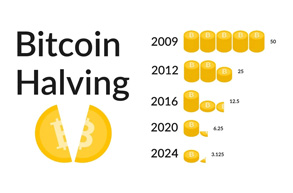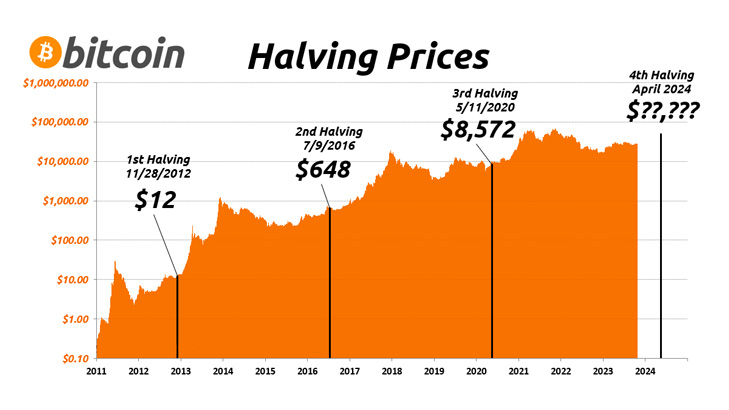What is halving and how does it affect the price of cryptocurrencies?
Halving is an event in the world of cryptocurrencies that reduces the number of new coins generated and issued as a reward to miners for mining a new block in the blockchain.

This event occurs at regular intervals and is a built-in deflation mechanism for many cryptocurrencies, including Bitcoin.
Halving directly affects the price of cryptocurrencies, since it reduces the rate of increase in the supply of coins, and this, with stable demand, can cause the price to rise.
If we talk about the most popular cryptocurrency Bitcoin, then Bitcoin halvings occurred every 210,000 blocks, that is, approximately once every four years.
- The first halving happened in 2012, when the block reward decreased from 50 to 25 BTC.
- The second halving occurred in 2016, reducing the reward to 12.5 BTC.
- The third halving took place in 2020 and the block reward was reduced to 6.25 BTC.
- The fourth is planned for April 18-21, 2024, there will be a reduction to 1.125
Each of these halvings was accompanied by significant interest from investors and speculators, as well as discussion of the potential impact on the price of Bitcoin and other cryptocurrencies. While historical data shows a trend for prices to rise following halvings, it is important to remember that the cryptocurrency market is subject to many factors that can influence prices.

Analysis of past halvings shows that this event can have a significant impact on market value.
Consider Bitcoin as the most famous example:
- After the first halving in 2012, the price of Bitcoin increased from $12 to $1,000 within a year.
- The second halving in 2016 also provoked a significant increase in price; in 2017, Bitcoin soared to $20,000.
- The third halving took place in May 2020 and was again marked by an increase in the value of the first cryptocurrency. At the end of 2020, Bitcoin reached new all-time highs of $28,000 per coin.
However, it is important to understand that halving is not the only factor influencing the price of cryptocurrencies. Market value also depends on many other aspects, including regulatory news, technology updates, market demand and macroeconomic trends.
An interesting feature is that the price begins to rise long before the start of halving; all investors know that after the event there will be growth and are actively buying coins.

A few days before the event, demand falls, and with it the price of the cryptocurrency rolls back, but if you did not manage to sell your coins at the highest price, you should not be upset. As statistics from previous years show, the price will resume growth again and bring profit.
In addition to Bitcoin, halving also applies to other cryptocurrencies, this is also an excellent chance to make money:
Litecoin (LTC): Halving occurs every 840,000 blocks, which is approximately 4 years.
Bitcoin Cash (BCH): Halving occurs every 630,000 blocks, which is approximately 4 years.
Ethereum (ETH): difficulty bomb, complication of mining, occurs at the request of the developers.
Forecasts and expectations for future halvings vary among investors and analysts, but many agree that these events can stimulate an increase in price. This is due to the limited supply of new coins, while demand remains at the same level.
However, it is difficult to predict exact numbers or market reaction, and investors should always exercise caution and not rely solely on the halving as a guaranteed upside trigger.
Brokers for trading cryptocurrencies - https://time-forex.com/kriptovaluty/brokery-kriptovalut

